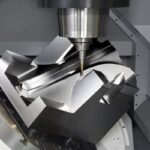The automotive industry is constantly evolving, demanding manufacturing processes that are not only reliable but also cost-effective for mass-producing high-quality plastic components. In 2021, the global injection molding automotive sector was valued at an estimated $261.8 billion, highlighting its critical role in the industry.
Traditional manufacturing methods often fall short when it comes to speed, cost, and consistency. Automotive businesses need solutions that can meet production demands without exceeding budgets.
This is where injection molding for car parts steps in. This efficient and economical method is ideal for producing large volumes of durable, precision-engineered plastic parts for vehicles. In this comprehensive guide, we will explore everything you need to know about Injection Molding Car Parts, empowering you to make informed decisions for your automotive manufacturing needs.
What are Injection Molding Car Parts?
Injection molding car parts are components manufactured using a high-pressure process that injects molten plastic material into a mold cavity. This technique is a cornerstone of modern automotive manufacturing, utilized extensively to create a vast array of parts, from exterior body panels to intricate interior elements and even under-the-hood components. Its prevalence in both Original Equipment Manufacturer (OEM) and aftermarket sectors underscores its importance.
The process begins with plastic resin, which is melted and then forcefully injected into a meticulously crafted mold. This mold, precisely machined, dictates the final shape and dimensions of the car part. Once the molten plastic fills the mold, it is cooled to solidify, resulting in robust parts with complex geometries and fine details. Common plastics used in injection molding for car parts include polypropylene, ABS, nylon, and other specialized polymers, chosen for their specific properties and performance characteristics in automotive applications.
The Key Benefits of Injection Molding for Car Parts
The automotive industry widely adopts injection molding due to its numerous advantages. Let’s examine the core benefits that make injection molding the preferred method for manufacturing car parts:
1. Cost-Effectiveness in Car Part Production
In the competitive automotive market, cost-effectiveness is paramount. Injection molding excels in this area due to its inherently efficient high-volume production capabilities. Compared to traditional methods, injection molding significantly accelerates production rates, reducing per-part costs.
Furthermore, material waste is minimized in injection molding. Precise material usage and the ability to recycle plastic waste contribute to substantial cost savings. By leveraging injection molding, automotive manufacturers can achieve significant economies of scale, producing high-quality car parts while optimizing their budgets.
2. Speed and Efficiency in Manufacturing Automotive Components
Time is of the essence in automotive manufacturing cycles. Injection molding offers unparalleled speed and efficiency. The process is highly automated, utilizing sophisticated machinery and computer controls. This automation drastically reduces cycle times, enabling rapid production of car parts.
This speed translates directly to increased productivity and faster turnaround times for automotive manufacturers. In a fast-paced industry where time-to-market is crucial, injection molding’s efficiency provides a significant competitive advantage.
3. High Quality and Precision for Automotive Standards
Quality is non-negotiable in the automotive industry, where safety and performance are paramount. Injection molding delivers consistently high-quality car parts that meet stringent industry standards. Precision injection molding techniques ensure uniform part thickness, eliminating structural weaknesses and guaranteeing consistent quality across large production runs.
The tight tolerances achievable with injection molding ensure that each car part conforms precisely to design specifications. This precision is critical for ensuring proper fit, function, and reliability of automotive assemblies. The repeatable accuracy of injection molding provides automakers with the dependability they require.
4. Durability and Reliability of Plastic Car Parts
Automotive components must withstand harsh conditions and demanding use. Injection molded plastic car parts, especially those made from materials like ABS and polypropylene, offer exceptional durability and longevity. These materials are engineered to endure temperature variations, vibrations, and chemical exposure commonly encountered in automotive environments.
Plastic car parts produced through injection molding are robust and impact-resistant. Their ability to withstand wear and tear contributes to the overall durability and extended lifespan of vehicles. This reliability is a key factor in enhancing vehicle quality and customer satisfaction.
5. Design Flexibility and Complexity for Innovative Car Designs
Injection molding empowers automotive designers with remarkable design freedom. The process accommodates intricate shapes, complex geometries, and fine details that are often challenging or impossible to achieve with traditional manufacturing methods. This design flexibility opens up new possibilities for automotive innovation and aesthetics.
Automotive manufacturers can utilize injection molding to create uniquely styled and highly functional car parts. From complex dashboard designs to aerodynamic body panels, injection molding facilitates the realization of innovative automotive concepts. This capability allows for differentiation and the creation of visually appealing and cutting-edge vehicles.
6. Versatility Across Automotive Applications
Injection molding’s versatility extends to the wide range of car parts it can produce. It is not limited to specific vehicle types or component categories. From classic cars to modern sedans, SUVs, trucks, and even specialty vehicles, injection molding is applicable across the automotive spectrum.
Injection molding manufactures both exterior and interior car parts. Exterior components like grilles, bumpers, fenders, and trim pieces, as well as interior elements such as dashboards, door panels, consoles, and trim, are all efficiently produced using this technique. This versatility makes injection molding an indispensable process for comprehensive vehicle manufacturing.
The Injection Molding Process for Car Parts: A Step-by-Step Overview
The injection molding process for car parts is a refined and well-established manufacturing methodology. Here’s a simplified breakdown of the key steps:
-
Design and Mold Creation: The process begins with designing the car part using CAD (Computer-Aided Design) software. This digital design is then used to create a precision mold, typically from steel or aluminum, which will serve as the template for the injection molding process.
-
Material Preparation: Plastic resin, in the form of pellets or granules, is fed into the injection molding machine. The machine heats the plastic material until it melts into a viscous liquid state.
-
Injection: The molten plastic is then injected under high pressure into the mold cavity. The pressure ensures that the plastic fills all sections of the mold, even intricate details.
-
Cooling and Solidification: Once the mold is filled, the plastic is allowed to cool and solidify within the mold cavity. Cooling channels within the mold facilitate temperature regulation and accelerate the solidification process.
-
Ejection: After the plastic has solidified and formed the car part, the mold opens, and the finished part is ejected. Automated systems typically handle part ejection and collection.
-
Finishing (Optional): Depending on the application and design requirements, the injection molded car parts may undergo secondary finishing processes, such as trimming, painting, or assembly.
Ready to Explore Injection Molding for Your Car Parts?
Injection molding stands out as a highly effective and advantageous method for mass-producing plastic car parts for the automotive industry. Its cost-effectiveness, speed, quality, durability, design flexibility, and versatility make it an ideal choice for a wide range of automotive components.
If you’re considering injection molding for your automotive manufacturing needs, we are here to assist you. Contact us today for a free custom quote and let us help you bring your car part designs to life with precision and efficiency.

